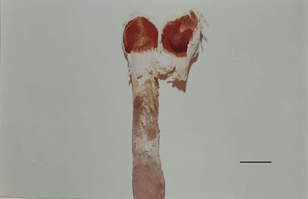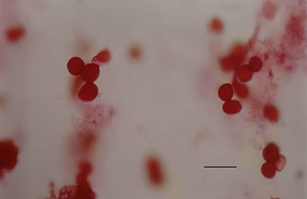Podaxis saharianus G. Moreno & MornandCryptogamie Mycologie 18: 247-254(1997) Fig. 7
MycoBank number: MB 437387; Index Fungorum number: IF 437387; Facesoffungi number: FoF 09750; Fruiting body – stipitate, bulbous, 12.0 –16.0 cm tall, dry, bulb and stipe diffentiated only by a difference of 1.0–1.5 mm in dimensions of diameter. Stipe– cylindrical to subcylindrical to flattened, 7.5–10.5 × 1.5–3.5 cm, broad at the base to form a small bulb of intermingled sand and hyphae. Peridium –ellipsoidal, subcylindrical or fusiform, 5.5–8.5 × 2.5–4.0 cm creamish white, uniformly scaly. Exoperidium – creamish-white.
Endoperidium – deep reddish-brown, dehiscing longitudinally at maturity and fragile when dry. Gleba – deep reddish- brown only at the topmost part, base of gleba near stipe portion is white to cream. Spores –10.0–12.0 × 8.0–10.0 µm, deep red to fuscous reddish brown, thick but smooth walled, ovoid to ellipsoid possessing a short apiculus, with prominent distal germ pore.
Ecology and distribution – Moreno & Mornand (1997) reported Podaxis saharianus from xerophytic habitats in Morocco for the first time. This hardy species flourishes well in a nutrient-poor environment, well drained sandy soil after rainfall and has a shelf life of three to five days.
Specimens examined – JNV/Mycl/164, 20 August 2018 in zone IC on sand dunes, collected by Reenu Chouhan. 28°01’3.43″N73°18’53.82″E Bikaner, elevation: 242 m (794 ft), 26°55’3.47″N70°54’13.93″E Jaisalmer, elevation: 225 m (738 ft), 28°18’0.00″N74°57’0.00″E Churu, elevation:292 m (958 ft).
Note – Moreno & Mornand (1997) reported different specimens of Podaxis with larger spores in comparison to other species of Podaxis. Furthermore, these specimens display a much thinner stipe making the cap appear more bulbous in the deserts of Morocco and Iraq and they classified them as Podaxis saharianus. According to the phylogenetic analysis of the Podaxis specimens obtained from South Africa by Conlon et al. (2016), specimens were similar to P. saharianus with the large spores as has been reported in the findings of the Clade C of that research. According to Conlon et al. (2019), an adaptation was stated to maximize reproductive success and minimize the cost of growth in a nutrient-poor environment as the fungus would need more resources to establish itself in sandy environments when compared to the nutrient-rich termite mounds in grassy areas. Additionally, the thick walls would help to prevent desiccation. According to the present findings, it was concluded that the desert specimens found in sandy habitats form a monophyletic group. This was notable, different from other Podaxis specimens with termite associations and it has been reported here as P. saharianus.

a

b
Fig. 7–a Fruiting body of Podaxis saharianus collected from sand dunes. b Spores. Scale bar: a = 5 cm,b = 20 µm.
